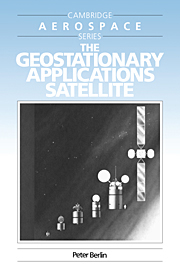Book contents
- Frontmatter
- Contents
- Dedication
- Preface
- List of Acronyms
- 1 Launch vehicles
- 2 The transfer orbit
- 3 The geostationary orbit
- 4 The satellite environment
- 5 Structures
- 6 Mechanisms
- 7 Thermal control
- 8 Power supply and conditioning
- 9 Propulsion and orbit control
- 10 Attitude stabilization, measurement and control
- 11 Telemetry, tracking and command (TT&C)
- 12 Communications payload
- 13 Meteorological payload
- 14 Product assurance
- 15 Spacecraft development and testing
- Index
- Frontmatter
- Contents
- Dedication
- Preface
- List of Acronyms
- 1 Launch vehicles
- 2 The transfer orbit
- 3 The geostationary orbit
- 4 The satellite environment
- 5 Structures
- 6 Mechanisms
- 7 Thermal control
- 8 Power supply and conditioning
- 9 Propulsion and orbit control
- 10 Attitude stabilization, measurement and control
- 11 Telemetry, tracking and command (TT&C)
- 12 Communications payload
- 13 Meteorological payload
- 14 Product assurance
- 15 Spacecraft development and testing
- Index
Summary
Introduction
We live in a world of “room temperature technology” as far as electronics and chemicals are concerned. The ambient temperature in the technologically developed parts of the world is in the range of 0–30°C. Nearly all space-qualified materials are derived from earthbound applications, be it electronic components, electrolytes, lubricants, paints or adhesives. Equipment on earth having a tendency to run too hot or too cold may be readily brought back to acceptable operating temperatures through heat exchange with the atmosphere.
In space, however, there is only extreme cold and extreme heat. If no action were taken, passive satellite equipment would adopt temperatures from typically − 200 to + 150°C, while active electronics might reach temperatures of several hundred degrees. To make things worse, a satellite will occasionally dive into the earth's shadow and emerge again into sunlight, such that fierce thermal stresses develop within the spacecraft. Because vacuum prevails, there is no heat convection. The only heat exchange is through radiation and conduction, and they are poor substitutes for convection when it comes to creating some kind of temperature balance.
It is therefore necessary to create approximate room temperature inside a spacecraft where most of the electronics and chemicals are found. This is the task of spacecraft thermal control. Passive control using thermal blankets, paints and other surface treatments go a long way to Create the right operational environment, but sometimes it is necessary to resort to active control with the aid of electric heaters, louvres and heat pipes.
- Type
- Chapter
- Information
- The Geostationary Applications Satellite , pp. 83 - 91Publisher: Cambridge University PressPrint publication year: 1988



